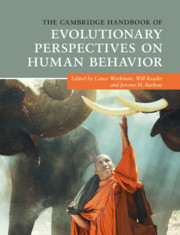Book contents
- The Cambridge Handbook of Evolutionary Perspectives on Human Behavior
- The Cambridge Handbook of Evolutionary Perspectives on Human Behavior
- Copyright page
- Dedication
- Contents
- Figures
- Tables
- Contributors
- Preface
- Acknowledgments
- Part I The Comparative Approach
- Part II Sociocultural Anthropology and Evolution
- Part III Evolution and Neuroscience
- Part IV Group Living
- 10 The Problem of Altruism and Future Directions
- 11 Can Evolutionary Processes Explain the Origins of Morality?
- 12 The Evolution and Function of Third-Party Moral Judgment
- 13 Evolution of the Human Family
- 14 The Parasite-Stress Theory of Cultural Values and Sociality
- 15 The Evolution of Pride and Shame
- 16 Thinking Outside the Head
- Part V Evolution and Cognition
- Part VI Evolution and Development
- Part VII Sexual Selection and Human Sex Differences
- Part VIII Abnormal Behavior and Evolutionary Psychopathology
- Part IX Applying Evolutionary Principles
- Part X Evolution and the Media
- Index
- References
10 - The Problem of Altruism and Future Directions
from Part IV - Group Living
Published online by Cambridge University Press: 02 March 2020
- The Cambridge Handbook of Evolutionary Perspectives on Human Behavior
- The Cambridge Handbook of Evolutionary Perspectives on Human Behavior
- Copyright page
- Dedication
- Contents
- Figures
- Tables
- Contributors
- Preface
- Acknowledgments
- Part I The Comparative Approach
- Part II Sociocultural Anthropology and Evolution
- Part III Evolution and Neuroscience
- Part IV Group Living
- 10 The Problem of Altruism and Future Directions
- 11 Can Evolutionary Processes Explain the Origins of Morality?
- 12 The Evolution and Function of Third-Party Moral Judgment
- 13 Evolution of the Human Family
- 14 The Parasite-Stress Theory of Cultural Values and Sociality
- 15 The Evolution of Pride and Shame
- 16 Thinking Outside the Head
- Part V Evolution and Cognition
- Part VI Evolution and Development
- Part VII Sexual Selection and Human Sex Differences
- Part VIII Abnormal Behavior and Evolutionary Psychopathology
- Part IX Applying Evolutionary Principles
- Part X Evolution and the Media
- Index
- References
Summary
Augustes Comte first coined the term “altruism” as a cornerstone for his ethic doctrine Positivism, describing it as selfless concern for another’s welfare (Sutton, 1982). The existence of altruism and basic human kindness has been heavily debated throughout history, permeating through psychological, philosophical, and theological fields. Early philosophical and religious figures discussed concepts such Saint Augustine’s theory of conscience – that basic human kindness was an innate human feature (Fortin, 1996) – or Thomas Aquinas’ synderesis rule, which states that humans desire to be good and can innately distinguish between right and wrong (Davies, 2014). While these speculations have little or no empirical basis, they do have something in common with more recent research: they view altruism as having an innate component. Augustine and Aquinas attributed God as the innate origin of human altruism. Evolutionary psychologists view altruism as genetically influenced, having arisen, in part, from the Darwinian selective forces of natural and sexual selection.
- Type
- Chapter
- Information
- Publisher: Cambridge University PressPrint publication year: 2020
References
- 5
- Cited by



